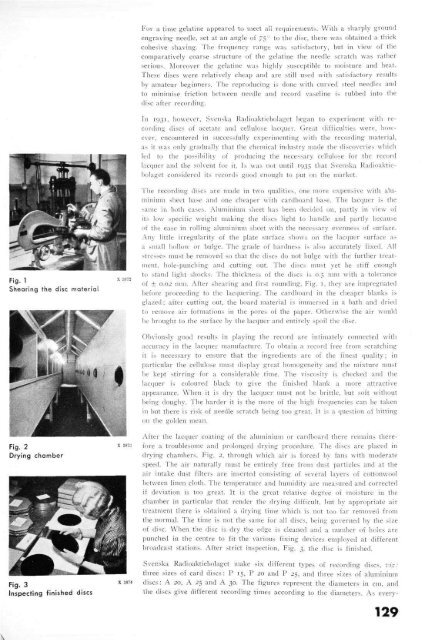contents - History of Ericsson - History of Ericsson
contents - History of Ericsson - History of Ericsson
contents - History of Ericsson - History of Ericsson
You also want an ePaper? Increase the reach of your titles
YUMPU automatically turns print PDFs into web optimized ePapers that Google loves.
\<br />
For a time gelatine appeared to meet all requirements. With a sharply ground<br />
engraving needle, set at an angle <strong>of</strong> 75° to the disc, there was obtained a thickcohesive<br />
shaving. The frequency range was satisfactory, but in view <strong>of</strong> the<br />
comparatively coarse structure <strong>of</strong> the gelatine the needle scratch was rather<br />
serious. Moreover the gelatine was highly susceptible to moisture and heat.<br />
These dises were relatively cheap and are still used with satisfactory results<br />
by amateur beginners. The reproducing is done with curved steel needles and<br />
to minimise friction between needle and record vaseline is rubbed into the<br />
disc after recording.<br />
In 1931, however, Svenska Radioaktiebolaget began to experiment with recording<br />
discs <strong>of</strong> acetate and cellulose lacquer. Great difficulties were, however,<br />
encountered in successfully experimenting with the recording material,<br />
as it was only gradually that the chemical industry made the discoveries which<br />
led to the possibility <strong>of</strong> producing the necessary cellulose for the record<br />
lacquer and the solvent for it. Is was not until 1935 that Svenska Radioaktiebolaget<br />
considered its records good enough to put on the market.<br />
The recording discs are made in two qualities, one more expensive with aluminium<br />
sheet base and one cheaper with cardboard base. The lacquer is the<br />
same in both cases. Aluminium sheet has been decided on, partly in view <strong>of</strong><br />
its low specific weight making the discs light to handle and partly because<br />
<strong>of</strong> the ease in rolling aluminium sheet with the necessary evenness <strong>of</strong> surface.<br />
Any little irregularity <strong>of</strong> the plate surface shows on the lacquer surface as<br />
a small hollow or bulge. The grade <strong>of</strong> hardness is also accurately fixed. All<br />
stresses must be removed so that the discs do not bulge with the further treatment,<br />
hole-punching and cutting out. The discs must yet be stiff enough<br />
to stand light shocks. The thickness <strong>of</strong> the discs is 0.5 mm with a tolerance<br />
<strong>of</strong> ± 0.02 mm. After shearing and first rounding, Fig. 1, they are impregnated<br />
before proceeding to the lacquering. The cardboard in the cheaper blanks is<br />
glazed; after cutting out, the board material is immersed in a bath and dried<br />
to remove air formations in the pores <strong>of</strong> the paper. Otherwise the air would<br />
be brought to the surface by the lacquer and entirely spoil the disc.<br />
Obviously good results in playing the record are intimately connected with<br />
accuracy in the lacquer manufacture. To obtain a record free from scratching<br />
it is necessary to ensure that the ingredients are <strong>of</strong> the finest quality; in<br />
particular the cellulose must display great homogeneity and the mixture must<br />
be kept stirring for a considerable time. The viscosity is checked and the<br />
lacquer is coloured black to give the finished blank a more attractive<br />
appearance. When it is dry the lacquer must not be brittle, but s<strong>of</strong>t without<br />
being doughy. The harder it is the more <strong>of</strong> the high frequencies can be taken<br />
in but there is risk <strong>of</strong> needle scratch being too great. It is a question <strong>of</strong> hitting<br />
on the golden mean.<br />
After the lacquer coating <strong>of</strong> the aluminium or cardboard there remains therefore<br />
a troublesome and prolonged drying procedure. The discs are placed in<br />
drying chambers, Fig. 2, through which air is forced by fans with moderate<br />
speed. The air naturally must be entirely free from dust particles and at the<br />
air intake dust filters are inserted consisting <strong>of</strong> several layers <strong>of</strong> cottonwool<br />
between linen cloth. The temperature and humidity are measured and corrected<br />
if deviation is too great. It is the great relative degree <strong>of</strong> moisture in the<br />
chamber in particular that render the drying difficult, but by appropriate air<br />
treatment there is obtained a drying time which is not too far removed from<br />
the normal. The time is not the same for all discs, being governed by the size<br />
<strong>of</strong> disc. When the disc is dry the edge is cleaned and a number <strong>of</strong> holes are<br />
punched in the centre to fit the various fixing devices employed at different<br />
broadcast stations. After strict inspection, Fig. 3, the disc is finished.<br />
Svenska Radioaktiebolaget make six different types <strong>of</strong> recording discs, vis:<br />
three sizes <strong>of</strong> card discs: P 15, P 20 and P 25, and three sizes <strong>of</strong> aluminium<br />
discs: A 20, A 25 and A 30. The figures represent the diameters in cm, and<br />
the discs give different recording times according to the diameters. As every-<br />
129
















